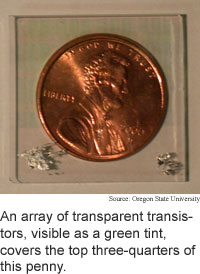
See-through circuits closer
The transparent computer displays featured
in the film Minority Report were made possible by special effects, but real-world
transparent electronics are on the horizon.
Researchers from the Tokyo Institute of Technology (TITech) in Japan
and Japan Science and Technology Corporation (JST) have altered a type of
transparent oxide so that it conducts electricity, and have constructed
a transistor from the material. And Oregon State University researchers
have made a transparent transistor from zinc oxide, a common, cheap ingredient
of suntan lotion.
The two transistors are significant improvements over the first
transparent transistors made in 1996. Plastic transparent transistors have
been under development for several years for use in electronic paper and
flexible displays. In contrast, the TITech/JST and Oregon State transparent
transistors are made from sturdier inorganic materials.
The TITech/JST transistor is very efficient, but expensive to produce.
The Oregon State transistor could increase display efficiency and brightness
by 10 to 20 percent, according to the researchers.
Inorganic transparent transistors could find practical use in two
to five years, and be used for transparent displays in 5 to 15 years, according
to the researchers. The TITech/JST work appeared in the May 23, 2003 issue
of Science. The Oregon State work appeared in the February 3, 2003 issue
of Applied Physics Letters.
Chip sorts colors
Software referees group calls
Prefab key to molecular memory
Wires make wireless strain gauge
News briefs:
See-through circuits closer
Protein traps nanoparticles
Nods drive audio interface
Nano rapid prototyping advances
Practical nanotube fiber near
Nanotube transistors make memory

Research Watch blog
View from the High Ground Q&A
How It Works
RSS Feeds:
News
Ad links:
Buy an ad link
Ad links: Clear History
Buy an ad link
|
TRN
Newswire and Headline Feeds for Web sites
|
© Copyright Technology Research News, LLC 2000-2010. All rights reserved.